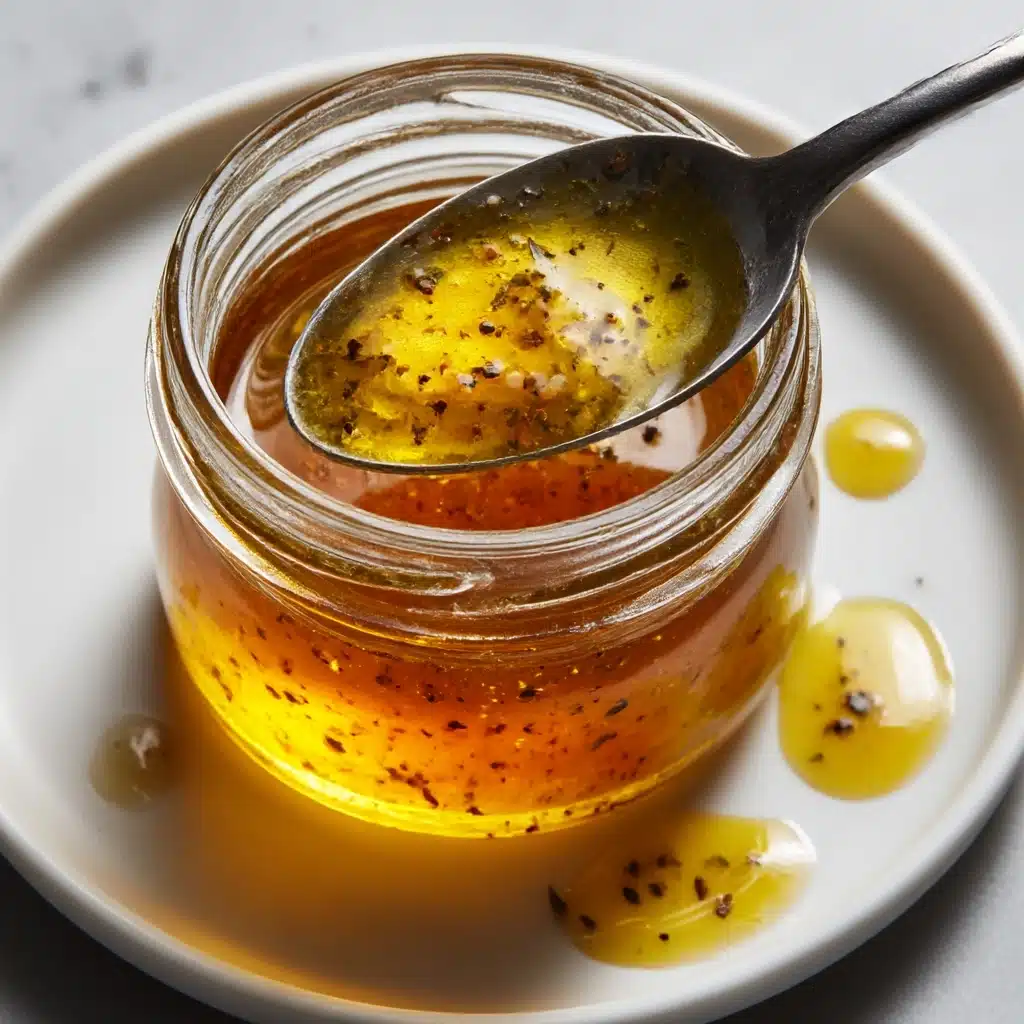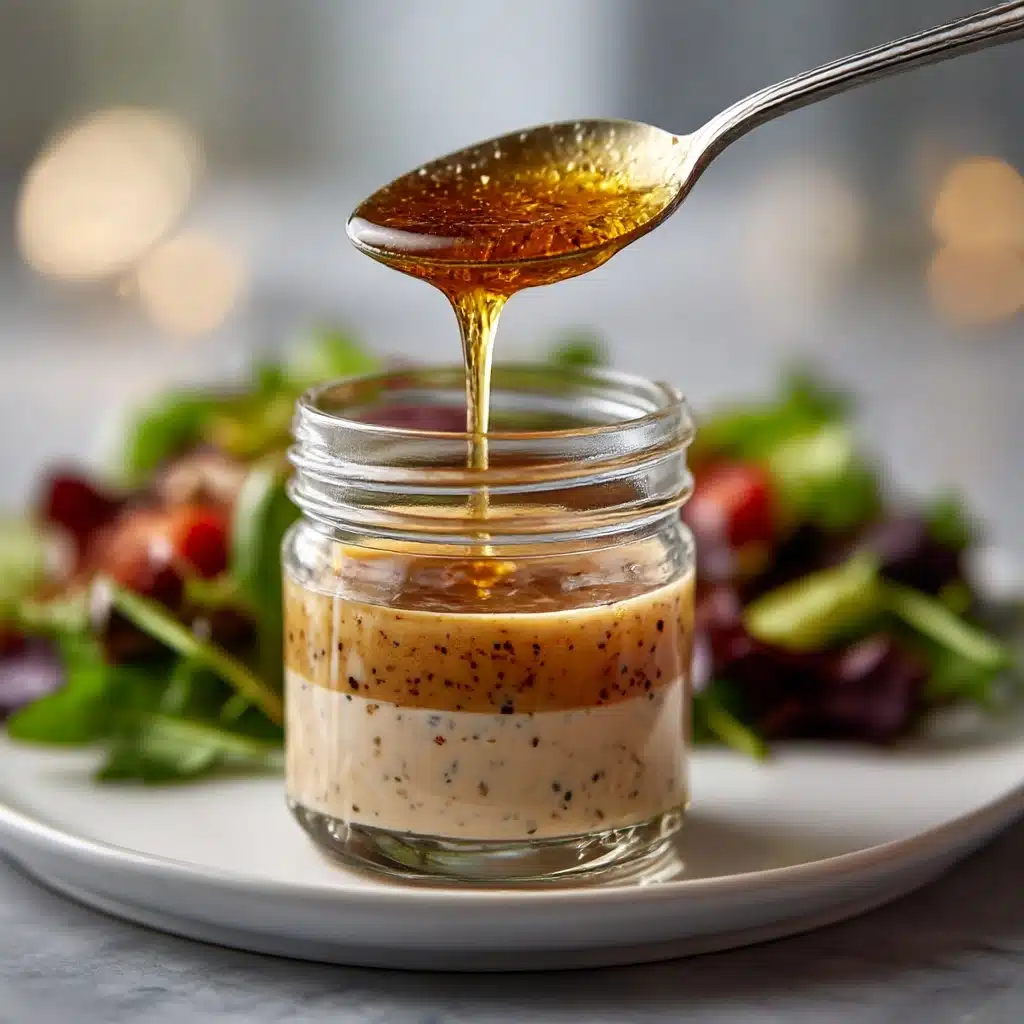If you’re after an irresistible burst of Mediterranean flavor, this Greek Salad Dressing is about to become your go-to kitchen staple. Bright, tangy, and aromatic, it whips together in five minutes and instantly elevates anything it touches—from classic Greek salad to grilled veggies and more. With a careful blend of extra-virgin olive oil, red wine vinegar, Dijon mustard, zesty garlic, and a sprinkle of oregano, each spoonful introduces you to the sun-soaked flavors of Greece, right in your own home.
Ingredients You’ll Need
Making a Greek Salad Dressing is a breeze, and each ingredient brings its magic: a peppery richness, a citrusy punch, or an herby note that dances on your tongue. Here’s what you’ll need and why each element matters:
- Extra-virgin olive oil (1/2 cup): The backbone of any stellar Greek Salad Dressing, it provides a silky texture and fruity undertone that ties everything together.
- Red wine vinegar (3 tablespoons): This adds a lively tang that’s crucial for that signature sharpness and balances the richness of the olive oil.
- Dijon mustard (1 teaspoon): A touch of Dijon helps emulsify the dressing, ensuring it stays creamy, not oily, and gives a subtle, savory depth.
- Garlic, minced (1 clove): For that irresistible punch—fresh garlic infuses the entire dressing with a bold, mouthwatering aroma.
- Dried oregano (1 teaspoon): A classic Greek flavor, its earthy herbaciousness gives the dressing its authentic, Mediterranean edge.
- Salt (1/2 teaspoon): Enhances and balances all the other flavors for a truly harmonious blend.
- Black pepper (1/4 teaspoon): Adds just enough warmth and kick to keep things interesting.
- Honey, optional (1/2 teaspoon): If you like a whisper of sweetness to round out the acidity, honey is the perfect finishing touch.
How to Make Greek Salad Dressing
Step 1: Gather and Prep Your Ingredients
Before you begin, make sure all your ingredients are measured and ready to go. Mince the garlic finely so it will meld into the dressing without overpowering any bite, and have your spices on hand for a quick, seamless assembly.
Step 2: Whisk to Emulsify
Combine the extra-virgin olive oil, red wine vinegar, Dijon mustard, minced garlic, oregano, salt, and black pepper in a small bowl or a lidded jar. Whether you whisk energetically or give it a hearty shake, your goal is to create a smooth, glossy mixture that doesn’t separate—this is the hallmark of a truly great Greek Salad Dressing.
Step 3: Taste and Adjust
Give your dressing a little taste test. If the vinegar feels a bit too assertive, or you want a milder finish, blend in the optional honey and whisk again. This simple tweak can make your Greek Salad Dressing just the way you like it, balancing tang with a touch of soft sweetness.
Step 4: Refrigerate Until Needed
Transfer the dressing to a jar with a tight-fitting lid and store it in the refrigerator until you’re ready to use it. A quick shake or stir before each use will keep the flavors vibrant and evenly distributed throughout.
How to Serve Greek Salad Dressing

Garnishes
For a stunning finish, sprinkle your salad with crumbled feta cheese, a shower of freshly chopped parsley, or even a few Kalamata olives. These classic garnishes play so well with the zesty notes of Greek Salad Dressing, each bite is layered with color, texture, and an extra pop of Mediterranean feel.
Side Dishes
The beauty of Greek Salad Dressing is its versatility: drizzle it over roasted or grilled vegetables, toss it into a simple pasta salad, or use it as a marinade for grilled chicken or seafood. On a mezze platter, it also makes a fantastic dip for warm pita bread or fresh crudité.
Creative Ways to Present
Try serving the dressing in a vintage cruet or small glass jar right on the table for that bistro-style charm. You can also create personalized salad jars for a picnic or lunch on the go—just layer chopped veggies and feta, and pour the Greek Salad Dressing on top before sealing for a portable, flavor-packed treat.
Make Ahead and Storage
Storing Leftovers
This Greek Salad Dressing keeps beautifully in the refrigerator for up to a week. Store it in a glass jar or an airtight container, and remember to give it a good shake or stir before each use, as natural separation is perfectly normal.
Freezing
While it’s best enjoyed fresh, you can freeze the dressing if needed. Pour it into ice cube trays, freeze until solid, then transfer the cubes to a freezer bag. Thaw in the refrigerator and stir well before serving—the texture might change slightly, but the flavors will still sing!
Reheating
If your dressing solidifies in the fridge (thanks to the olive oil), let the jar come to room temperature for 10–15 minutes or dip it in a bowl of warm water. Give it a brisk shake and it should return to its perfectly pourable state, ready to dress your next salad.
FAQs
Can I make this Greek Salad Dressing without mustard?
Absolutely! Dijon mustard helps emulsify the dressing, but if you’re not a fan, you can mix the rest of the ingredients as shown. It’ll still taste fresh and delicious—just give it a shake before each use as it may separate more quickly.
Is it better to use fresh or dried oregano?
Dried oregano is traditional for Greek Salad Dressing, as it lends a concentrated, classic flavor that’s integral to Mediterranean cuisine. If you only have fresh oregano, use a bit more for a brighter, greener taste.
Can I use a different vinegar?
Red wine vinegar is what makes this dressing truly Greek, but if you’re out, try white wine vinegar or even lemon juice for a fresh twist. Each option changes the character slightly but keeps things vibrant and tasty.
How do I make this dressing vegan?
This recipe is already vegan as long as you skip the optional honey. The base is made with plant-based ingredients, making it suitable for a wide range of diets, including gluten-free eaters.
What else can I use Greek Salad Dressing for?
The versatility is endless! Brush it on grilled meats or fish, toss it into quinoa bowls, drizzle over roasted potatoes, or even mix into grain salads for a Mediterranean touch that livens up any meal.
Final Thoughts
Once you try this bright, homemade Greek Salad Dressing, you’ll never look at bottled dressings the same way again! It’s zippy, savory, and endlessly versatile—just the thing to bring a taste of the Mediterranean to your own table. Give it a go, play with the flavors, and enjoy how it transforms every salad and side into something unforgettable!
PrintGreek Salad Dressing Recipe
This Greek Salad Dressing is a classic vinaigrette with a Mediterranean twist, perfect for drizzling over fresh salads or using as a marinade. It’s easy to make and bursting with flavor.
- Prep Time: 5 minutes
- Cook Time: 0 minutes
- Total Time: 5 minutes
- Yield: 3/4 cup 1x
- Category: Condiment
- Method: No-Cook
- Cuisine: Greek
- Diet: Vegan, Gluten-Free
Ingredients
Ingredients:
- 1/2 cup extra-virgin olive oil
- 3 tablespoons red wine vinegar
- 1 teaspoon Dijon mustard
- 1 clove garlic, minced
- 1 teaspoon dried oregano
- 1/2 teaspoon salt
- 1/4 teaspoon black pepper
- Optional: 1/2 teaspoon honey for slight sweetness
Instructions
- In a small bowl or jar, whisk together the olive oil, red wine vinegar, Dijon mustard, garlic, oregano, salt, and black pepper until emulsified.
- Add honey if desired and whisk again.
- Taste and adjust seasoning if needed.
- Store in the refrigerator for up to 1 week and shake or stir before using.
Notes
- This dressing is perfect for traditional Greek salad but also pairs well with pasta salad, grilled vegetables, or as a marinade for chicken.
Nutrition
- Serving Size: 2 tablespoons
- Calories: 160
- Sugar: 0g
- Sodium: 115mg
- Fat: 18g
- Saturated Fat: 2.5g
- Unsaturated Fat: 15g
- Trans Fat: 0g
- Carbohydrates: 1g
- Fiber: 0g
- Protein: 0g
- Cholesterol: 0mg




